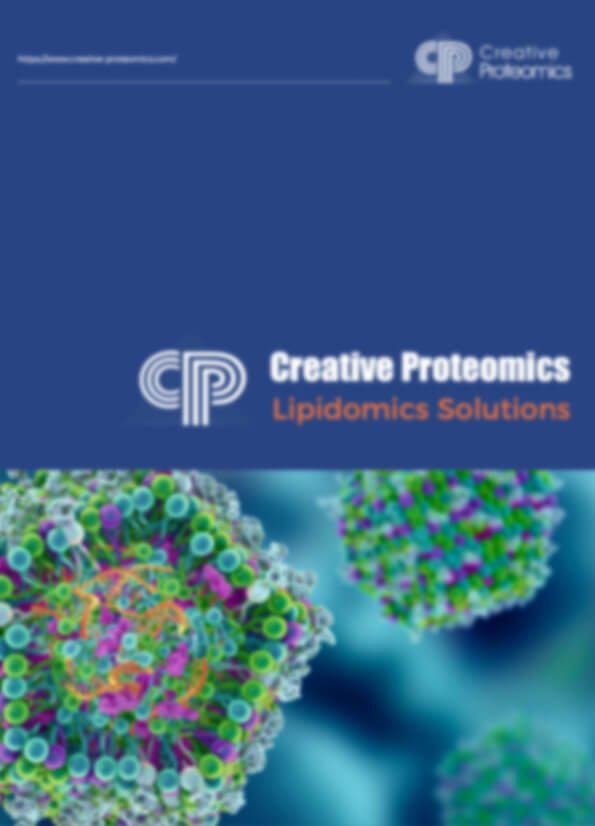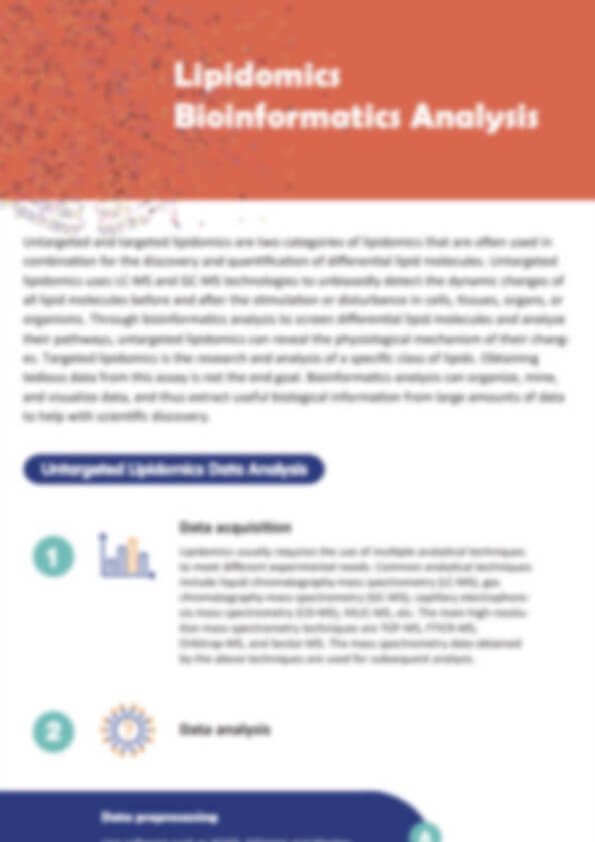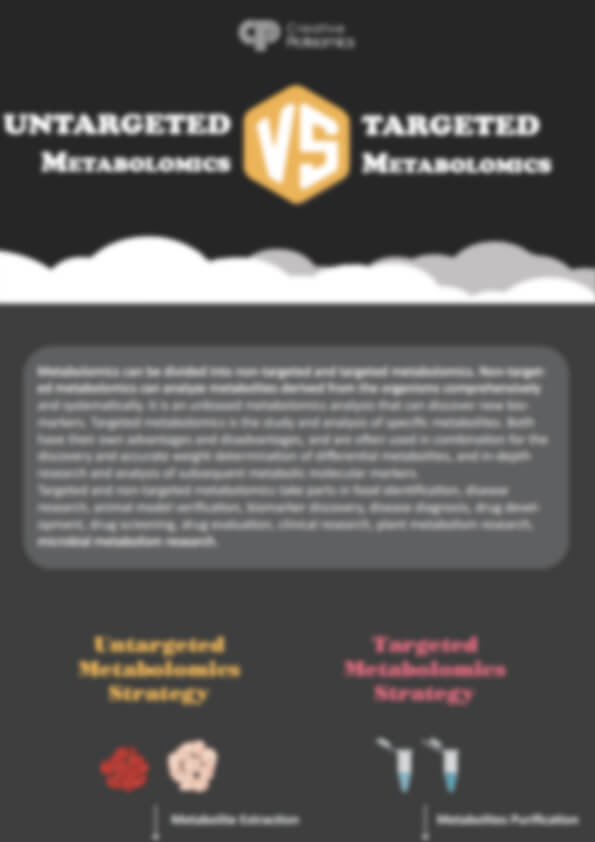Plasmalogen Analysis Service
Creative Proteomics specializes in high-precision plasmalogen analysis, which allows researchers to accurately resolve plasmalogen structures, quantify lipid species at ppt-level sensitivity, and explore peroxisomal biosynthesis pathways. Our services are designed to support research in lipid metabolism, nutritional science, and membrane biology, helping to deepen understanding of oxidative stress resilience, lipid remodeling, and metabolic regulation.
Submit Your Request Now
×- What We Provide
- Advantages
- Technology Platform
- Sample Requirements
- FAQ
- Publications
What is Plasmalogen?
Plasmalogens are a unique subclass of ether phospholipids characterized by a vinyl ether bond at the sn-1 position and an ester bond at the sn-2 position of the glycerol backbone. These lipids are predominantly found in the membranes of the brain, heart, and immune cells, where they play critical roles in maintaining membrane fluidity, acting as endogenous antioxidants by scavenging reactive oxygen species (ROS), and supporting neuroprotection and synaptic function. Structurally, plasmalogens are distinguished by their head groups, which are primarily ethanolamine (PlsEtn) or choline (PlsCho), and their radyl chains, which typically include polyunsaturated fatty acids (PUFAs) like ω-3 or ω-6 derivatives at the sn-2 position.
Plasmalogens are essential for cellular function and are particularly abundant in tissues with high metabolic activity. For example, they constitute 32% of the glycerophospholipids in the human heart and 20% in the brain, with even higher concentrations in myelin sheaths. Their unique vinyl ether bond not only contributes to membrane dynamics but also provides a protective role against oxidative stress, making them vital for cellular integrity and signaling pathways.
Plasmalogen Analysis Service Offered by Creative Proteomics
- Comprehensive Plasmalogen Profiling – Qualitative and quantitative assessment of plasmalogens in biological and food samples.
- Plasmalogen Structural Characterization – Detailed structural elucidation of plasmalogen species, including sn-1 and sn-2 fatty acyl composition.
- Lipid Metabolite Identification – Detection of plasmalogen-related metabolites, including degradation products and oxidative derivatives.
- Pathway Analysis – Evaluation of plasmalogen biosynthesis and degradation pathways through targeted lipidomic approaches.
- Comparative and Quantitative Analysis – Comparative studies across different sample types, conditions, and treatment groups.
List of Detected Plasmalogens and Related Metabolites
| Category | Detected Compounds |
|---|---|
| Plasmalogen Phosphatidylethanolamines (PlsEtn) | PlsEtn 16:0, PlsEtn 18:0, PlsEtn 18:1, PlsEtn 20:4, PlsEtn 22:6 |
| Plasmalogen Phosphatidylcholines (PlsCho) | PlsCho 16:0, PlsCho 18:0, PlsCho 18:1, PlsCho 20:4, PlsCho 22:6 |
| Plasmalogen Phosphatidylserines (PlsPSer) | PlsPSer 18:0, PlsPSer 18:1, PlsPSer 20:4 |
| Plasmalogen Sphingomyelins (PlsSM) | PlsSM 16:0, PlsSM 18:1, PlsSM 20:4 |
| Oxidative Metabolites | Lyso-plasmalogens (e.g., Lyso-PlsEtn 18:0), Oxidized plasmalogen aldehydes (e.g., hexanal, 4-hydroxy-2-hexenal) |
| Biosynthetic Intermediates | Alkyl-DHAP (Dihydroxyacetone phosphate), Glycerophosphoethanolamine, Glycerophosphocholine |
| Fatty Acids | Fatty alcohols (e.g., hexadecanol, octadecanol), Polyunsaturated fatty acids (PUFAs) (e.g., arachidonic acid, docosahexaenoic acid) |
| Degradation Products | Plasmalogen-derived aldehydes (e.g., hexanal, heptanal), Hydroperoxides, Hydroxylated plasmalogens |
| Plasmalogen-Related Pathways | Peroxisomal fatty acid metabolism, Ether lipid biosynthesis, Glycerophospholipid biosynthesis, Oxidative stress pathways |
| Plasmalogen Phosphatidylcholines (PlsCho) | PlsCho 16:0, PlsCho 18:0, PlsCho 18:1, PlsCho 20:4, PlsCho 22:6 |
Advantages of Plasmalogen Assay
- Ultra-High Sensitivity: Detection limits as low as parts-per-trillion (ppt) are achieved using advanced mass spectrometry platforms, enabling precise quantification of low-abundance plasmalogens even in complex biological matrices like brain tissues or plasma.
- Multi-Dimensional Profiling: Simultaneous analysis of plasmalogen classes (e.g., PlsEtn, PlsCho), oxidative metabolites (e.g., lyso-plasmalogens), and biosynthetic pathway intermediates (e.g., alkyl-DHAP) provides a holistic view of lipid remodeling and peroxisomal activity.
- Structural Specificity: Unique methodologies resolve plasmalogen-specific features, such as the vinyl ether bond at sn-1 and PUFA esterification at sn-2, differentiating them from diacylphospholipids.
- High-Throughput Compatibility: Optimized workflows support parallel processing of 200+ samples per batch with a turnaround time of 10–20 business days, ideal for large-scale lipidomics studies.
- Data Reproducibility: Intra- and inter-assay coefficients of variation (CV <10%) ensure reliable quantification across technical replicates, critical for longitudinal or comparative analyses.
Technology Platform for Plasmalogen Analysis Service
Liquid Chromatography (LC) System
- Instrument: Thermo Scientific™ Vanquish™ UHPLC
- Column: Hypersil GOLD C18 (2.1 mm × 100 mm, 1.7 µm particle size)
- Mode: Reverse-phase chromatography with 0.1% formic acid for enhanced ionization efficiency.
Mass Spectrometry (MS) Platform
- Instrument: Thermo Scientific™ Q Exactive™ HF-X Hybrid Quadrupole-Orbitrap™
- Resolution: 240,000 at m/z 200
- Scan Speed: 40 Hz for rapid data acquisition
- Ionization Mode: Electrospray ionization (ESI) in negative ion mode
- Mass Range: m/z 50–6,000
Data Acquisition and Processing
- Full-Scan MS: High-resolution lipid profiling
- Targeted MS/MS: Parallel Reaction Monitoring (PRM) for quantitative analysis
- Software: LipidSearch™ for automated identification and pathway mapping

Vanquish™ UHPLC (Figure from Thermo)

Q Exactive™ Plus Hybrid Quadrupole-Orbitrap™ Mass Spectrometer (Figure from Thermo)
Sample Requirements for Plasmalogen Analysis Service
| Sample Type | Minimum Amount Required | Container Type | Storage Conditions | Additional Notes |
|---|---|---|---|---|
| Serum / Plasma | 200 µL | Cryovial (Labelled) | -80°C, shipped on dry ice | Avoid hemolysis; centrifuge to remove debris before freezing. |
| Tissue (Brain, Heart, Liver) | 50 mg | Sterile Tube (Labelled) | -80°C, shipped on dry ice | Flash-freeze in liquid nitrogen immediately after collection. Avoid thawing before analysis. |
| Cultured Cells | 1 × 10⁷ cells | Cryovial (Pellet) | -80°C, shipped on dry ice | Wash cells with PBS, remove supernatant, and flash-freeze. Provide detailed cell line information. |
| Food Samples (e.g., Fish, Dairy) | 500 mg | Sterile Tube or Sealed Bag | -80°C, shipped on dry ice | Homogenize large samples if needed. Provide detailed sample origin and preparation information. |
| Biofluids (e.g., CSF, Urine) | 500 µL | Cryovial (Labelled) | -80°C, shipped on dry ice | Pre-filter or centrifuge to remove debris. Avoid multiple freeze-thaw cycles. |
Applications of Plasmalogen Assay Service
Comprehensive profiling of plasmalogens to investigate lipid metabolism, membrane dynamics, and lipid remodeling.
Oxidative Stress Studies
Assessment of plasmalogen degradation and oxidative metabolites to explore cellular antioxidant defense mechanisms.
Nutritional and Food Science
Quantification of plasmalogens in dietary sources like seafood and dairy for nutritional analysis and food quality assessment.
Aging and Neurodegeneration Research
Monitoring plasmalogen levels to study lipid alterations associated with aging and neurodegenerative conditions.
Biomarker Discovery
Identification of plasmalogen-related biomarkers for disease progression studies and therapeutic monitoring.
Peroxisomal Function Analysis
Evaluation of plasmalogen biosynthesis and metabolism to investigate peroxisomal activity and associated disorders.
Demo
FAQ of Plasmalogen Analysis Service
Why is high sensitivity important in plasmalogen analysis?
Plasmalogens are often present at trace levels in complex samples like brain tissue or plasma. Our Q Exactive™ HF-X platform achieves parts-per-trillion (ppt) sensitivity, ensuring accurate detection even in low-abundance scenarios.
How are plasmalogens distinguished from other lipids?
Unique structural features—such as the vinyl ether bond at sn-1 and PUFA esterification at sn-2—are resolved using targeted MS/MS and specialized chromatography, differentiating plasmalogens from diacylphospholipids.
How do you prevent plasmalogen oxidation during processing?
Antioxidants (e.g., BHT) are added during extraction, and negative ion mode ESI minimizes oxidative damage during ionization.
Can different plasmalogen subclasses (e.g., PlsEtn vs. PlsCho) be quantified?
Yes. Our LC-MS/MS workflow separates subclasses and quantifies them individually, enabling precise tracking of lipid remodeling.
What is the turnaround time?
Standard analysis takes 10–20 business days; high-throughput batches (200+ samples) follow the same timeline.
How is data processed and reported?
LipidSearch™ software automates lipid identification, pathway mapping, and generates user-friendly reports with raw data in Excel/PDF formats.
Are there species-specific differences in plasmalogens?
Yes. For example, marine organisms often show higher ω-3 PUFA-containing plasmalogens, while mammals like humans have distinct brain and heart profiles.
How does oxidative stress impact results?
Oxidation degrades plasmalogens into byproducts like aldehydes. We recommend rapid sample freezing and antioxidant use to minimize this effect.
Learn about other Q&A.
Plasmalogen Analysis Service Case Study
Publications
Here are some of the lipidomics-related papers published by our clients:

- Prospective randomized, double-blind, placebo-controlled study of a standardized oral pomegranate extract on the gut microbiome and short-chain fatty acids. 2023. https://doi.org/10.3390/foods13010015
- Laboratory evaluation of larvicidal and oviposition deterrent properties of edible plant oils for potential management of Aedes aegypti (Diptera: Culicidae) in drinking water containers. 2019. https://doi.org/10.1093/jme/tjz021
- Lipid Membrane Engineering for Biotechnology (Doctoral dissertation, Aston University). 2023. https://doi.org/10.48780/publications.aston.ac.uk.00046663
- Characterising Chinese Hamster Ovary cell extracellular vesicle production in biopharmaceutical manufacturing (Doctoral dissertation, University of Sheffield). 2022. https://etheses.whiterose.ac.uk/33062/
- White matter lipid alterations during aging in the rhesus monkey brain. 2024. https://doi.org/10.1007/s11357-024-01353-3
References
- Kolek, Jan, et al. "Changes in membrane plasmalogens of Clostridium pasteurianum during butanol fermentation as determined by lipidomic analysis." PLoS One 10.3 (2015): e0122058. https://doi.org/10.1371/journal.pone.0122058
- Donovan, Elise L., et al. "Lipidomic analysis of human plasma reveals ether-linked lipids that are elevated in morbidly obese humans compared to lean." Diabetology & metabolic syndrome 5 (2013): 1-13. https://doi.org/10.1186/1758-5996-5-24










